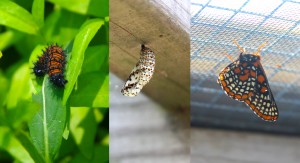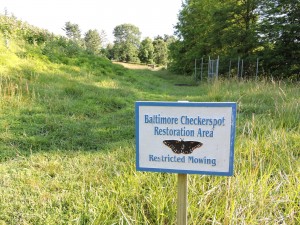This is the home of the Harford County Checkerspot Cooridor Team –
A local effort to restore the Baltimore Checkerspot Butterfly.
The Baltimore Checkerspot Butterfly has been Maryland’s official state insect since 1973. It was named for George Calvert, the first Lord Baltimore, for having the same colors that were represented in his heraldic shield. This freshwater, wetland species was once common in Maryland, occupying multiple sites in over 15 counties; however, in recent decades it has experienced significant population declines. Today, it occupies only 11 sites within 7 counties. The Baltimore checkerspot is included on the Maryland Department of Natural Resources’ list of Rare, Threatened and Endangered Animals. For detailed information please take a look at the MD DNR CHECKERSPOT PAGE
Although reasons for the Baltimore checkerspot’s decline are not completely understood, contributing factors include habitat loss and degradation, climate change, non-targeted exposure to insecticides, and overconsumption of its host plant, white turtlehead, by a large white-tailed deer population. Checkerspots depend on white turtlehead for facilitation of reproduction, nourishment, and protection from predation. Deer browsing on its host plant has undoubtedly played a large role in the decline. Checkerspot caterpillars feed almost exclusively on white turtlehead, especially in the summer when the caterpillars are small. As they become larger, they may use a variety of other host plants in addition to white turtlehead, including arrowwood viburnum, narrow-leaved plantain, penstemon, and honeysuckle. Adult checkerspots obtain nectar from flowering plants including common milkweed, dogbane, several species of mountain mint, and wild blackberry; but they depend on white turtlehead on which to lay their eggs.



